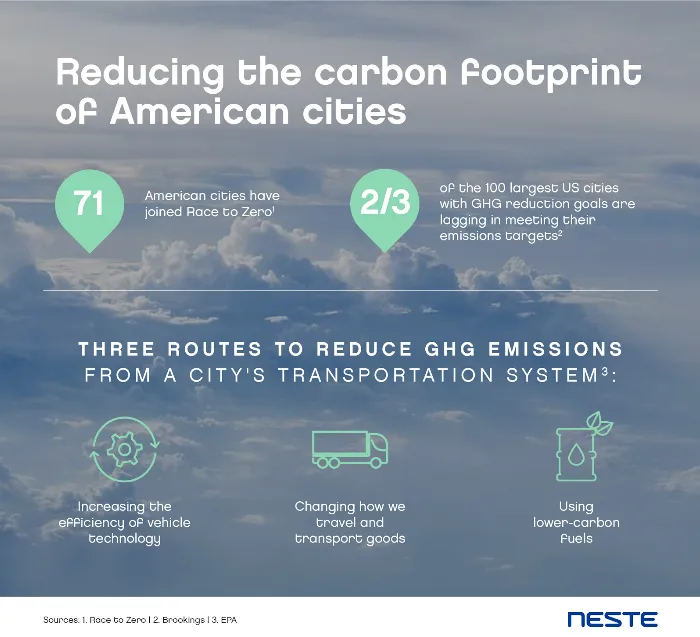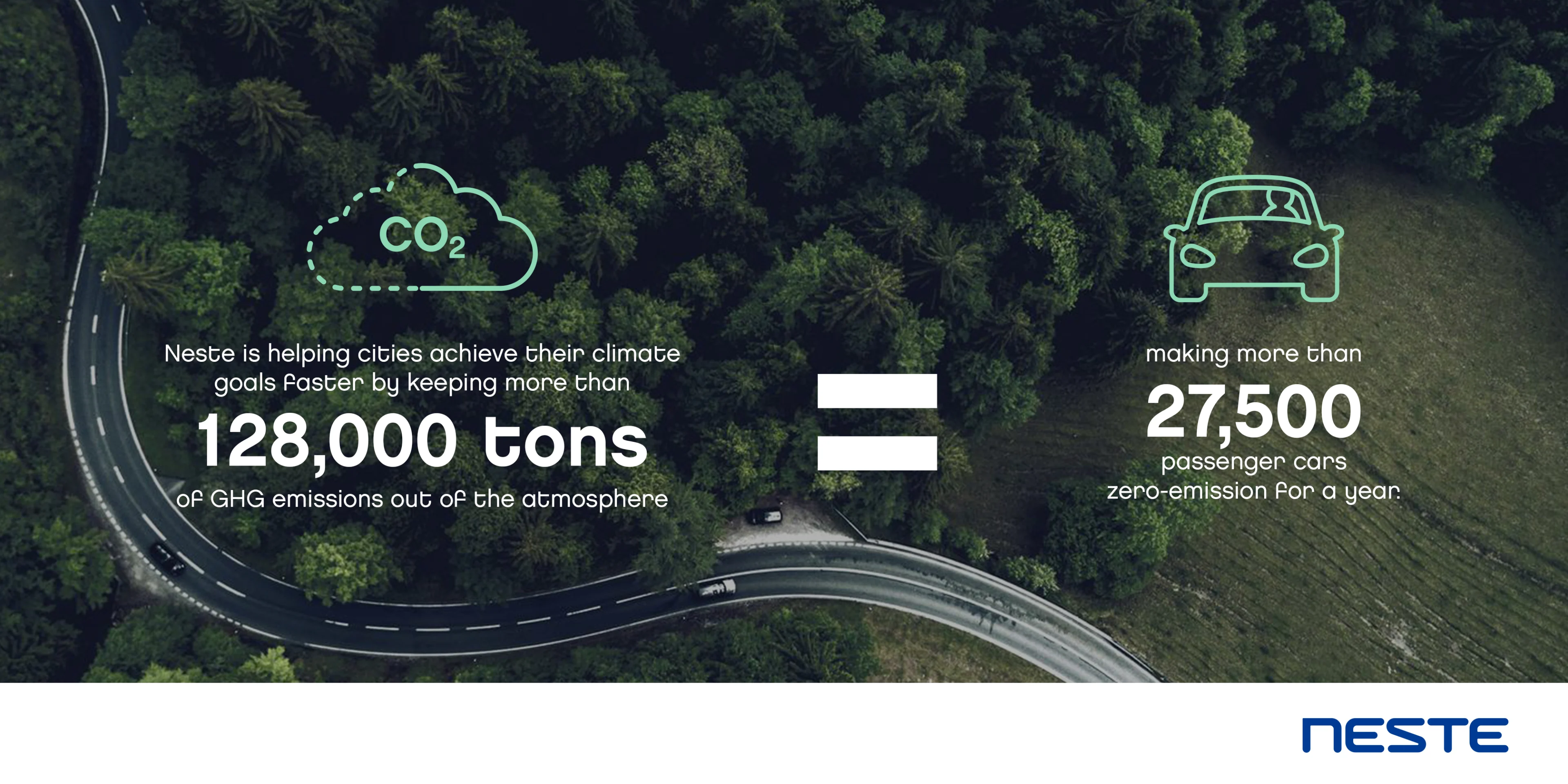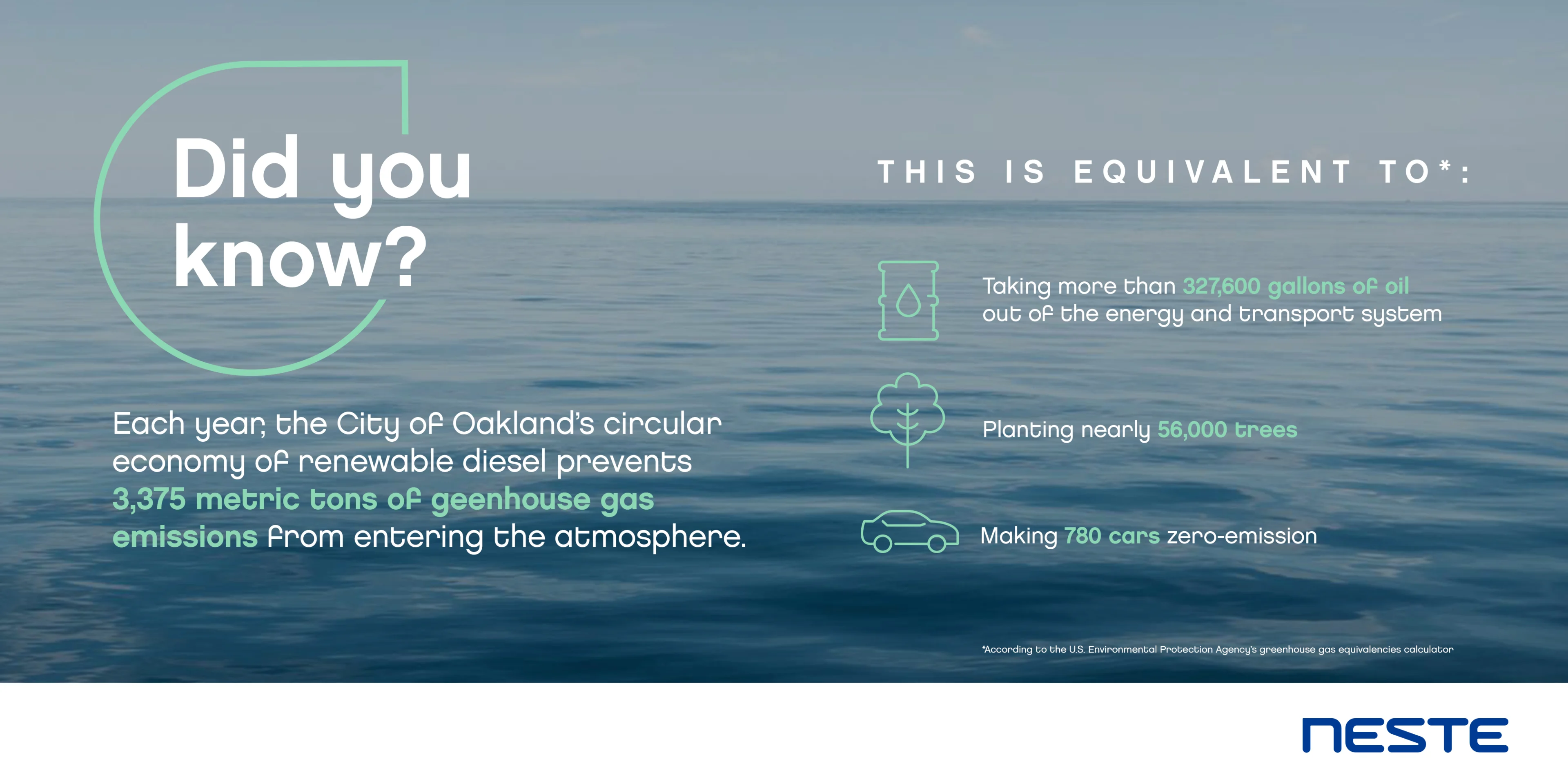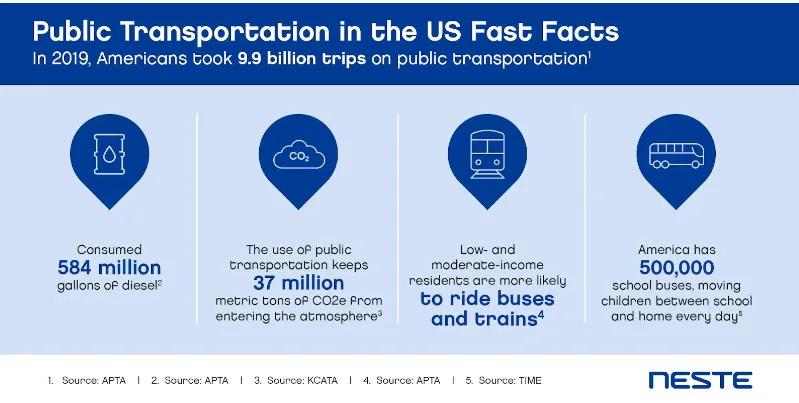
Case story
9 minute read
Helping cities fight climate change with renewable fuels
Across the U.S. West Coast, Neste is powering medium and heavy-duty vehicles including fire trucks, buses and refuse trucks of cities and municipalities with renewable diesel and reducing greenhouse gas (GHG) emissions significantly.
Did you know cities are responsible for 75% of global CO2 emissions?
Transportation and buildings are among the largest contributors to GHG emissions. With that in mind, the need for cities to phase out of fossil fuel and transition to a more sustainable transportation system is more prominent than ever. An NRDC report shows that natural disasters and health impacts from the burning of fossil fuels cause nearly $820 billion dollars in harm to the economy every year. Recognizing the need to create a healthier planet, many American cities have set bold ambitions to reduce their carbon footprint, pollution and environmental inequity. In the past decade, Neste has helped a number of American cities meaningfully reduce GHG emissions and fight climate change.

Oftentimes, cities face challenges, such as a limited budget, to drive that transition and the lack of viable low or zero emission solutions available at scale.
Specific to transportation, cities depend on medium and heavy-duty city fleets, such as fire trucks, public transit, refuse trucks, emergency vehicles and school buses. These vehicles are crucial to the safety and quality of life for a city’s citizens.
Reducing emissions from these vehicles - and knowing where to start - can be a challenge in itself. Repair costs can be high, downtime of vehicles can impact the service that cities offer to their residents, some cities might not have the budget for transitioning all of their vehicles to EVs or they might have old vehicles that emit even more pollution.
Thankfully, for these vehicles, renewable diesel offers a drop-in solution that delivers immediate GHG reductions and requires zero new investments. As a leading producer of renewable fuels, Neste is helping to provide American cities easy access to this renewable, drop-in fuel, so fighting climate change is as easy as filling up.
What are we doing?
Supplying renewable diesel to over 130 municipal customers along the U.S. West Coast, as well as school districts and local transit authorities.
Over 15 million gallons of Neste’s renewable diesel supplied to cities in the past year.
Helping cities achieve their climate goals faster by keeping more than 128,000 tons of GHG emissions out of the atmosphere, equivalent to making more than 27,500 passenger cars zero-emission for a year.

Helping cities meet their ambitious climate goals
Over 80% of the U.S. population resides in urban areas. As the sources of significant emissions and homes to large populations, cities are key to sustainable climate solutions. That’s why local governments are setting bold climate goals that include a faster transition to low and zero emission fleets.
For more than a decade, Neste has been enabling American businesses and cities to power their fleets with renewable diesel. The result is significantly less emissions with no extra costs. Renewable diesel works seamlessly with existing energy infrastructure and engines. Over the lifecycle, renewable diesel can emit up to 80% less emissions than fossil diesel. Even better, some cities are taking a step further to create a circular economy, so their vehicles can run on renewable diesel made from their own waste.
A world-changing idea: A #circularcconomy in Oakland
Much like other cities across the U.S., the City of Oakland knew they needed to take action to mitigate the effects of climate change. In 2020, the City adopted its 2030 Equitable Climate Action Plan, a comprehensive, ambitious strategy to address environmental, social and climate justice issues and reshape the City’s transportation sector. The City’s biggest goal? Reduce carbon emissions by nearly 60% by 2030 compared to 2005 levels.
Immediately the City started working with Neste and its fuel distributor Western States Oil (WSO) to create a circular economy, where locally sourced waste materials are used to create the renewable diesel that helps fuel the City. This inspiring partnership was recognized as a winner of Fast Company’s World Changing Ideas Awards in 2021. The results are clear - this partnership supports local businesses, reduces GHG emissions, and keeps waste out of landfills and drains. Now, the City’s municipal fleet, including refuse trucks, street sweepers, off-highway equipment and many other vehicles are being fueled with renewable diesel.

“Switching to renewable diesel does not cost any money (to modify our current engines or infrastructure). Not switching to renewable diesel costs us in climate change and excess emissions. It is the best investment any business or city could make,” said Oakland Mayor Libby Schaaf. “This ‘today’ solution has a huge effect on our operations and in the world.”
An ambitious climate goal to prioritize equity and well-being of Central California community
The City of San Leandro, a suburban city in Alameda County, is committed to achieving emissions reductions of 40% below 2005 levels by 2030 and 80% below 2005 levels by 2050. To support this plan, the City switched all 160 of its municipal vehicles from using petroleum diesel to only run on renewable diesel.
“This was one easy change that we could make ourselves. Municipal operations need to be the leader in shifting the mindset of residents and businesses that reducing greenhouse gas emissions is a worthy effort that involves everyone.” – Debbie Pollart, Public Works Manager, The City of San Leandro.
Because renewable diesel is a drop-in solution, the switch was seamless for the City and there was no disruption to service. Even better, the City’s fleet manager also noticed that the fuel burns cleaner, which leads to a reduction in maintenance needs and less downtime for fleets, helping the City achieve cost savings.
Making public transportation more sustainable
Public transportation is essential for Americans' livelihood for two reasons: First, it provides access to employment, community resources, medical care, and recreational opportunities in communities; Second, it is also part of the solution in the fight against climate change as traveling by public transportation uses less energy and produces less pollution per passenger than comparable travel in private vehicles.

The most common types of public transportation in the US are buses, subways, and light rails. Transit agencies across the nation are increasingly taking actions to reduce their own carbon emissions to further the GHG emission reduction benefits associated with public transportation. Across the US, 178 public transit agencies have signed up for the Federal Transit Administration’s Sustainable Transit for a Healthy Planet Challenge, which encourages them to take bold actions and investments to cut GHG emissions.
With over 500,000 vehicles, America's school bus fleet is the nation's largest public transportation network, providing transportation services for over 25 million students every day. However, 95% of the school buses are powered by fossil diesel, GHG emissions and other pollutants can pose a risk to the health of our children.
To accelerate the transition to a more sustainable future, cities and school districts are adopting zero-emission buses or transitioning to alternative fuel sources.
Today, Neste’s renewable diesel is powering bus fleets from 10 public transit agencies across the US West Coast, enabling over 117,000 passengers that rely on public transportation to travel sustainably.
Driving Oregon’s transportation industry toward a cleaner future
For over 50 years, TriMet has provided more than 3 billion rides through its transit system. However, these services were historically powered by fossil fuels.
Considering its impact on the environment, TriMet decided to make a change. Today, they have a bold climate action plan to be net zero by 2050, as well as support and improve environmental sustainability and stewardship, and address environmental and social justice issues. TriMet is now powering 700 of its fixed-route buses with renewable diesel. By doing so, TriMet expects to prevent more than 77,000 tons of GHG emissions from releasing into the atmosphere per year, which is equivalent to making 15,000 fossil fueled cars zero emission for a year.

Cleaner school buses and fresher air for students in Twin Rivers Unified School District
In 2017, Twin Rivers Unified School District, which serves more than 26,000 students, sought to reduce its GHG emissions through an aggressive climate action plan. What was expected to be a years-long process became an overnight success story upon switching to renewable diesel.
The original plan dictated the use of electric vehicles to reduce emissions and improve air quality. Twin Rivers used $7.5 million in grants to purchase 29 zero-emission electric school buses. However, this accounted for less than a quarter of its fleet. With that in mind, Twin Rivers realized that the only way to reach its goal of reducing GHG emissions, was to embrace multiple solutions.
Searching for a more affordable, scalable, and faster-acting solution, Twin Rivers Director of Transportation Timothy Shannon attended the 2018 Energy Independence Summit in Washington, D.C. There, he learned about the many benefits of renewable diesel. This drop-in fuel allowed Shannon to immediately transition 75 fossil diesel powered buses to renewable diesel. Shannon chose Neste as the school district’s preferred partner due to its 15-year history as a pioneer in the renewables space. As a result, the Twin Rivers USD’s school bus fleet is now one of the cleanest in the country, consisting of electric buses, natural gas, and renewable diesel. Since the switch, Twin Rivers and Neste have kept 523 metric tons of CO2 out of the atmosphere annually, which is equal to planting 8,648 trees every year.

Looking ahead
American cities have relied on fossil fuels to power transportation for over 150 years. This needs to come to an end as more people — whether they are city residents, investors, employees, or customers — demand action on climate change. Choosing to use renewable raw materials a resource and making the switch to renewable diesel is a simple way to divest from fossil fuels and a cost-effective step for cities to take to fight climate change. By creating a circular economy every vehicle, every piece of equipment, and every restaurant in cities can be a part of the solution that helps combat, not contribute, to climate change. For more information on the benefits of Neste MY Renewable Diesel, please visit: https://www.neste.us/neste-my-renewable-diesel
Credits:
Neste